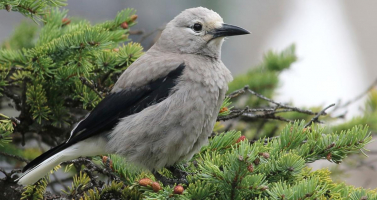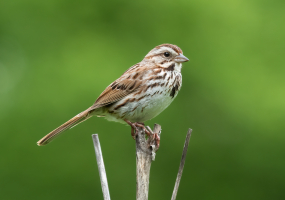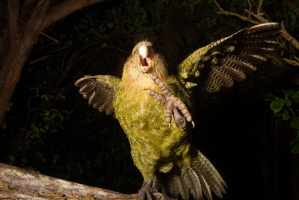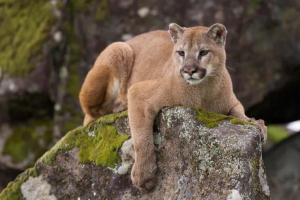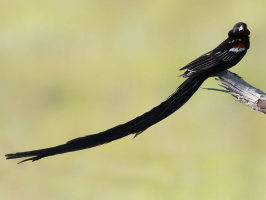Top 10 World's Beautiful Birds With Red Beaks
The part of a bird's body that is capable of harboring color and beauty is its feathers. In addition, some bird species' beaks can pique a great deal of ... read more...attention, with red-billed birds being the most well-known and elusive among nature enthusiasts. A regular-looking bird can be transformed from "just another bird in the crowd" to the center of attention by the simple act of possessing a stunning crimson beak. Below is a list of the most beautiful birds with red beaks in the world, let's find out!
-
The American White Ibis (Eudocimus albus) is a species of bird in the ibis family, Threskiornithidae. It is found from Virginia via the Gulf Coast of the United States south through most of the coastal New World tropics. This particular ibis is a medium-sized bird with a white overall plumage, a brilliant red-orange bill with a downward curve, long legs, and black wing tips that are typically only visible in flight. Males have longer bills and greater size than females.
The Gulf, Atlantic, Mexican, and Central American coasts are all included in the breeding range. The distribution encompasses the Caribbean as well as a larger portion of North America outside of the mating season. Additionally, it can be found in Colombia and Venezuela along the coast of northwestern South America. In the heart of Venezuela, many populations mix and breed with the scarlet ibis. Some experts have grouped the two together as a single species. Their main sources of food are tiny water animals like insects and tiny fish. In most areas, crayfish are its favorite food, but it can change its diet depending on the ecology and the availability of prey. Its primary method of foraging involves probing the bottom of shallow water with its beak in order to locate and seize its prey.

Wikipedia 
Bob Savage -
The Laughing Gull (Leucophaeus atricilla) is a medium-sized gull of North and South America. It is an opportunistic omnivore and scavenger with a laugh-like call. It breeds in vast colonies mostly along the Caribbean, North American Atlantic coast, and northern South American continent. The two subspecies are L. a. megalopterus – which can be seen from southeast Canada down to Central America and L. a. atricilla which appears from the West Indies to the Venezuelan islands. The laughing gull was long placed in the genus Larus until its present placement in Leucophaeus, which follows the American Ornithologists' Union.
It is simple to recognize this species. Its size ranges from 36 to 41 cm in length, 98 to 110 cm in wingspan, and 203 to 371g in weight. With the exception of its black head, dark-grey wings, and white body, summer adults are all white. Its wings are a much darker grey than all other gulls of similar size except the smaller Franklin's gull, and they have black tips without the white crescent shown by Franklin's. It has a long, red beak. In the winter, the black hood is mostly gone.

eBird 
American Bird Conservancy -
The Broad-Billed Hummingbird (Cynanthus latirostris) is a small-sized hummingbird that resides in Mexico and the southwestern United States. The bird is also known for its other common names – the Colibrí Pico Ancho in Spanish and the Colibri circé in French. It is a diurnal bird, consuming both nectar and insects. The hummingbird is also known to frequent sugar-water hummingbird feeders. Their eating habits revealed that the broad-billed hummingbird preferred to visit red or red-and-yellow flowers the most.
The male has a blue throat, white undertail coverts, and a dark green body. The male adult's wide, blackish-blue tail is distinctive. The feathers used for flight are grayish-brown. The adult female has a white eyestripe behind each eye and a pale belly. Her tail has white tips on the feathers. The male's bill is smaller but redder and more vivid. Males are bigger than females in terms of their wings and tails, both as juveniles and as adults. The youngsters' coloring tends to mimic that of the adult female. The juvenile males' throats eventually develop iridescent feathers, and their bills eventually turn red. The young boys lack the white-tipped tail that the females do.

eBird 
National Audubon Society -
The Caspian Tern (Hydroprogne caspia) is a species of tern, with a subcosmopolitan but scattered distribution. Despite its extensive range, it is monotypic of its genus and has no accepted subspecies. The genus name is from Ancient Greek hudros, "water", and Latin Progne "swallow". The specific caspia is from Latin and, like the English name, refers to the Caspian Sea. They feed mainly on fish, which they dive for, hovering high over the water and then plunging. On rare occasions, they will also consume huge insects, other animals' young, eggs, and rodents' young. To capture fish, they may fly up to 60 km away from the nesting colony; they frequently fish both at sea and in freshwater lakes.
With a length of 48–60 cm, a wingspan of 127–145 cm, and a weight of 530–782 g, it is the largest tern on the entire globe. Adult birds have long, thick red-orange bills with a little black tip and black legs. They have a white neck, belly, and tail, as well as a black crown on their white head. The underwings are pale with dark main feathers, whereas the upper wings and back are a light gray color. In flight, the tail is less forked than that of other terns, and the underside of the wingtips is black. In contrast to many other terns, the black cap is still present in winter, but the forehead has some white striping. The call is a loud croak resembling a heron.

eBird 
eBird -
The Black Oystercatcher (Haematopus bachmani) is a conspicuous black bird found on the shoreline of western North America. It ranges from the Aleutian Islands of Alaska to the coast of the Baja California peninsula. The black oystercatcher is a species of high conservation concern throughout its range (U.S., Canadian, Alaskan, and Northern & Southern Pacific Shorebird Conservation Plans), a keystone indicator species along the north Pacific shoreline, a management indicator species in the Chugach National Forest, and a U.S. Fish & Wildlife Service focal species for priority conservation action.
The black oystercatcher is a sizable shorebird that is totally black, with pink legs and a big, brilliant red bill. It features a red eye ring and a bright yellow iris. From north to south, its plumage varies little, becoming darker as it gets further north. Over most of its range, the black oystercatcher (Haematopodidae) is the only member of the family; on the Baja California coast, it partially overlaps with the American oystercatcher (H. palliatus). Although this name is also used locally for the blackish oystercatcher and the African oystercatcher, the term "black oystercatcher" is more frequently used within its range.

Wikipedia 
National Audubon Society -
The Northern Cardinal (Cardinalis cardinalis) is a bird in the genus Cardinalis; it is also known colloquially as the redbird, common cardinal, red cardinal, or just cardinal (which was its name prior to 1985). Southeast Canada, the eastern United States (from Maine to Minnesota to Texas, New Mexico, southern Arizona, and southern California), and further south via Mexico, Belize, and Guatemala are all places where it can be found. In several places, like Bermuda and Hawaii, it is also an invasive species. Woodlands, gardens, shrublands, and marshes all make up its habitat.
The northern cardinal is a medium-sized songbird with a body length of 21–23 cm. It has a characteristic crest on its head and a mask covering its face, which is gray on the female and black on the male. The female has a reddish olive tint, while the male is a bright red. Both sexes possess prominent raised crests and bright coral-colored beaks. The beak is cone-shaped and strong. Although it sometimes eats fruit and insects, the northern cardinal is mostly a granivore. The male displays a territorial attitude and sings to demarcate his domain. The male feeds the female seed while they are engaged in wooing. Apiece year, two to four clutches of three to four eggs each are laid.

eBird 
iNaturalist -
The Purple Grenadier (Granatina ianthinogaster) is a common species of estrildid finch. Despite being found throughout Eastern Africa, the best places to watch Purple Grenadiers are Kenya, the eastern and southern parts of Ethiopia, northeast Uganda, and north and central Tanzania. They are a resident bird species that live there all year long. These birds like the acacia thicket-covered, thorny scrub-covered, and occasionally open desert terrain. They can be found anywhere, up to an elevation of around 1600 meters above sea level.
The average length is 13.3 cm. Adults have a red bill, and all ages and sexes have a black tail. The male has a neck and head that are cinnamon in color, and an eye patch that is blue. The underparts are violet-blue with varying rufous patches and have a purple-blue rump. The female is smaller, predominantly cinnamon brown, and has silver-blue eye patches and white banding on the underparts. Female-like in appearance, juveniles are primarily tawny-brown with no bars and a reddish-brown bill.

eBird 
eBird -
The Buff-Bellied Hummingbird (Amazilia yucatanensis) is a medium-sized hummingbird. Their breeding grounds include woodlands and thickets that stretch from the lower Rio Grande Valley in Texas, in the southernmost part of the United States, to the Yucatán Peninsula in eastern Mexico, and on to northern Belize and northwest Guatemala. It favors semi-arid scrub, thickets along watercourses, and pine-oak woodlands. In a safe area, such as a tree or shrub, the female constructs a nest. Aggressively defending feeding areas within his or her territory are males and females of all ages. Every female lays two white eggs.
Adults have an above coloration of metallic olive green and a buffy lower breast. The primary wings and tail are forked and rufous in color. White makes up the underwing. The male's bill is straight and extremely thin. It has a darker tip and is red in color. The throat is a golden-green metallic color. The female is less colorful than the male and has an upper bill that is darker.

eBird 
Hummingbirds Plus -
The Common Tern (Sterna hirundo) is a seabird in the family Laridae. The four subspecies of this bird breed in temperate and subarctic regions of Europe, Asia, and North America, giving rise to its circumpolar range. It is very migratory, spending the winter in tropical and subtropical coastal areas. Breeding adults have orange-red legs, a narrow pointed bill, light grey upperparts, and white to very light grey underparts. They also have a black cap. The bill may be entirely black or predominantly red depending on the subspecies. The Arctic tern, one of the numerous species that are closely related, can be distinguished based on vocalizations, leg and bill color, and specifics of the plumage.
The common tern breeds in a wider variety of environments than any of its relatives, and it easily adapts to manmade platforms like floating rafts. It nests on any flat, sparsely vegetated surface near water. The nest may be nothing more than a rough patch of gravel or sand, but it is frequently lined or bordered with whatever trash is nearby. Up to three eggs may be placed, and on an open beach, their muted hues and splotchy patterns serve as camouflage. The eggs are incubated by both sexes and hatch in around 21–22 days, however, this time may be extended if a predatory animal disturbs the colony. In 22–28 days, the downy chicks fledge.

eBird 
eBird -
The Tufted Puffin (Fratercula cirrhata), also known as the crested puffin, is a relatively abundant medium-sized pelagic seabird in the auk family (Alcidae) found throughout the North Pacific Ocean. Tufted puffins frequently choose cliffs or islands that are generally off-limits to predators, close to fertile waters, and high enough for them to successfully take to the air. The ideal environment is a steep slope with grass for digging burrows and a rather soft soil base.
The largest puffin, the tufted puffin measures around 35 cm in length, has a comparable wingspan and weighs about 1.6 lbs. Male and female birds often have slightly different sizes, with birds from the western Pacific population being slightly larger than those from the eastern Pacific. Like other puffin species, they have a very thick bill that is primarily red with some yellow and rarely green patterns. They are primarily black with a white face patch. The yellow tufts (Latin: cirri), which appear annually on birds of both sexes as the summer breeding season approaches, are their most distinguishing characteristic and the source of their name.
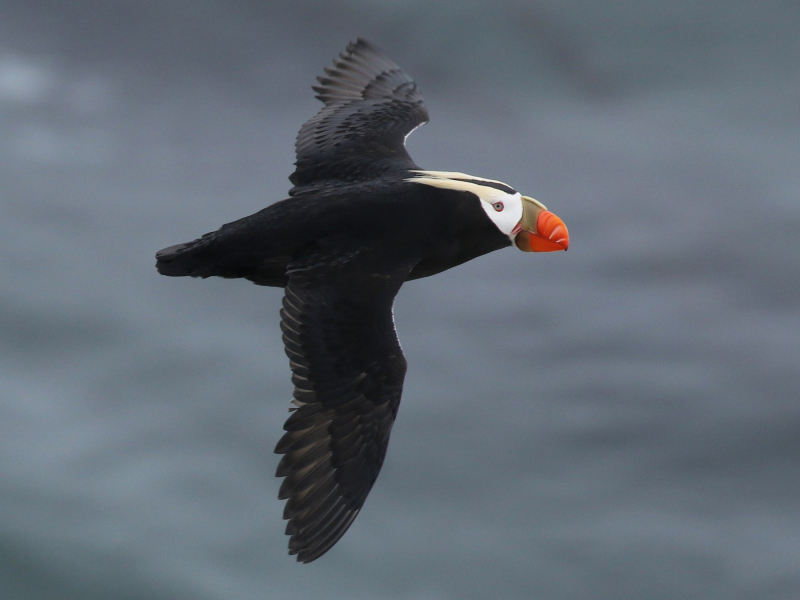
eBird 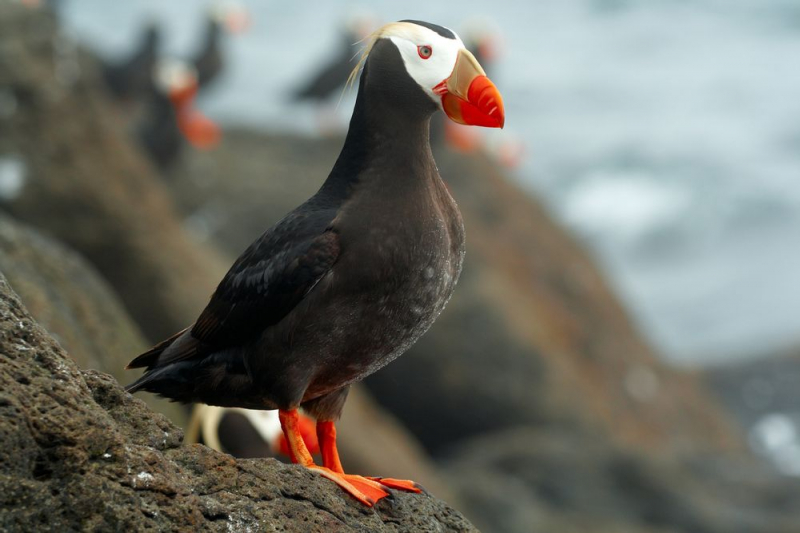
Kidadl



















